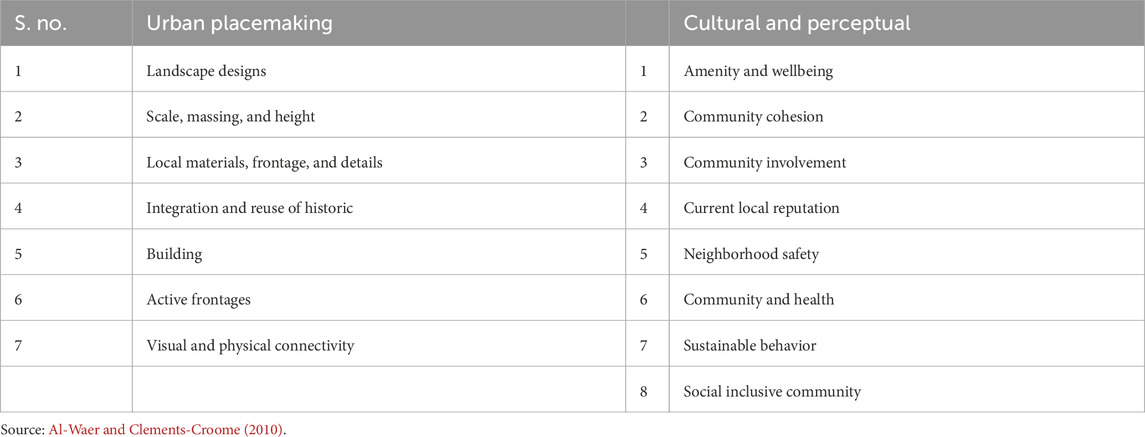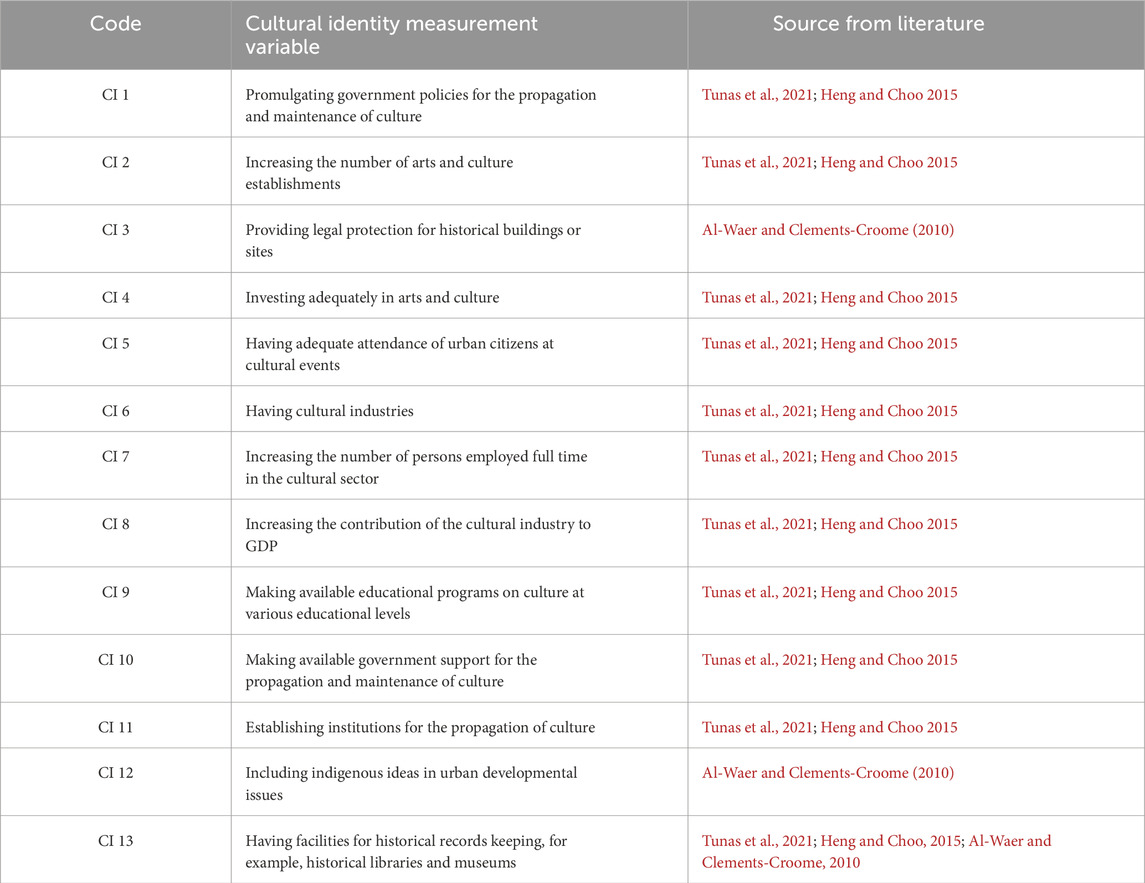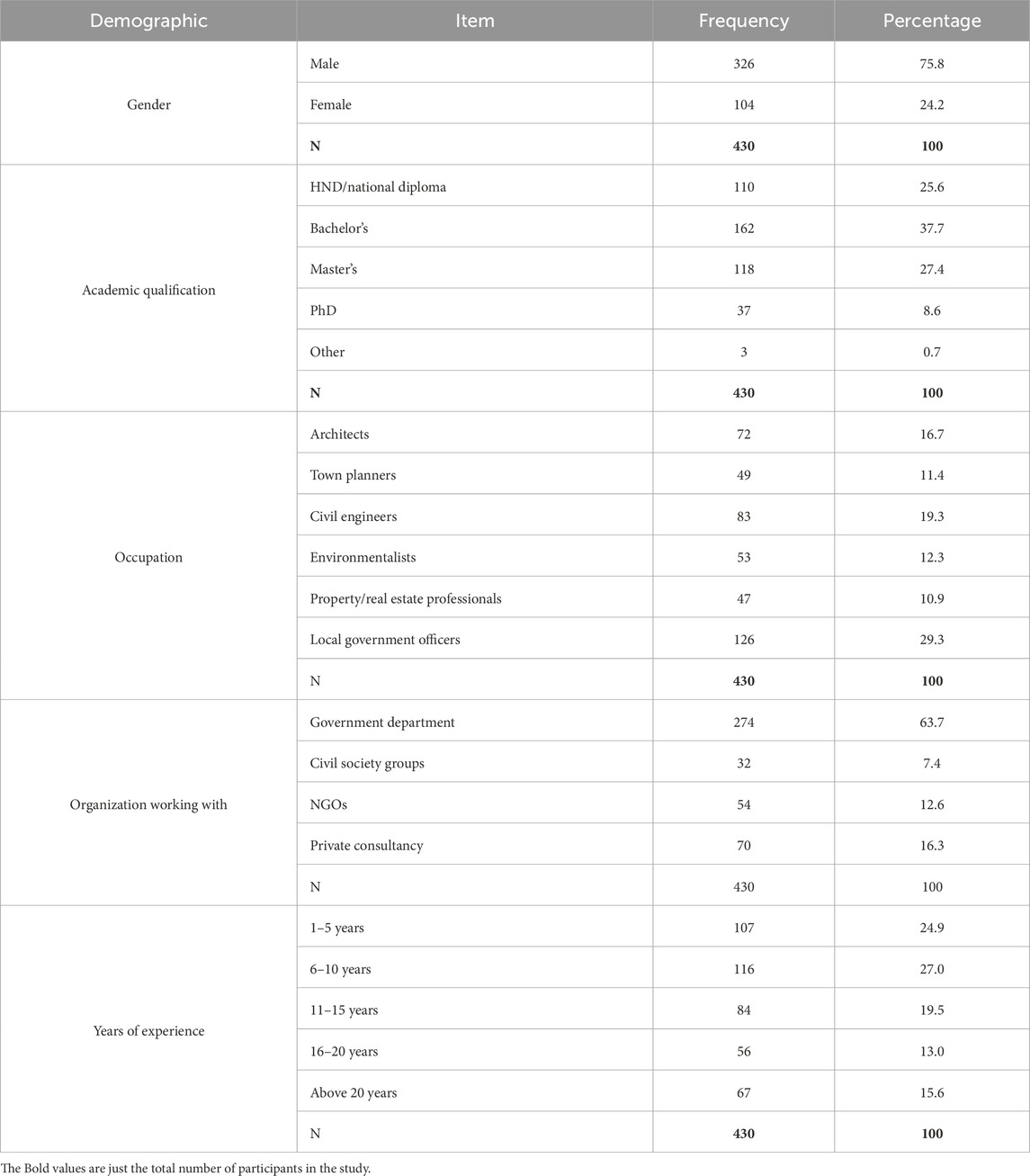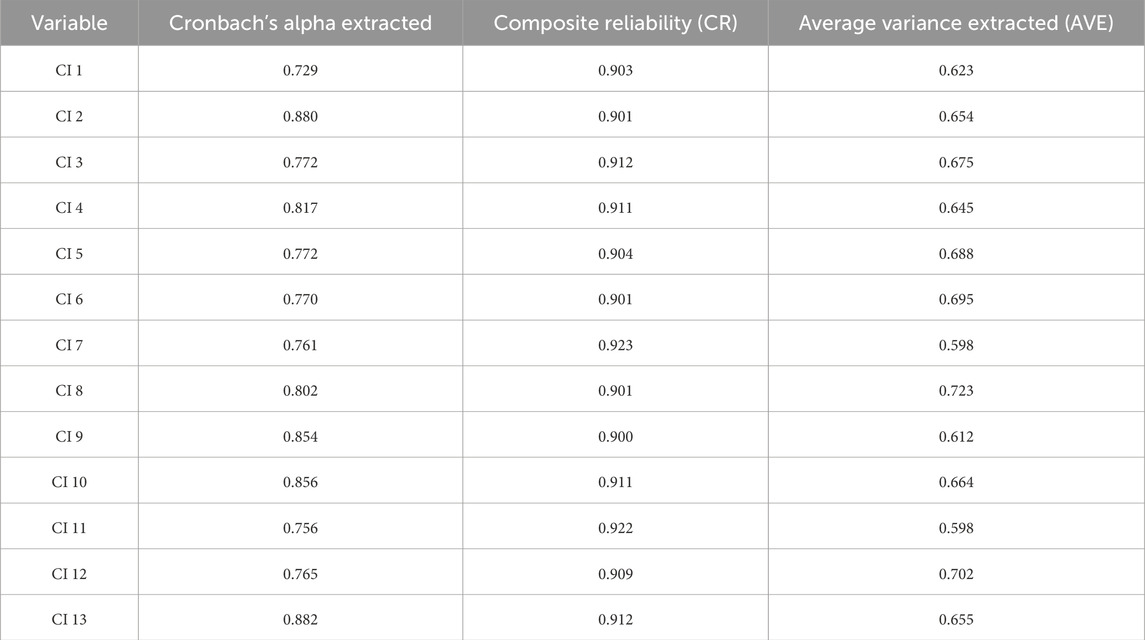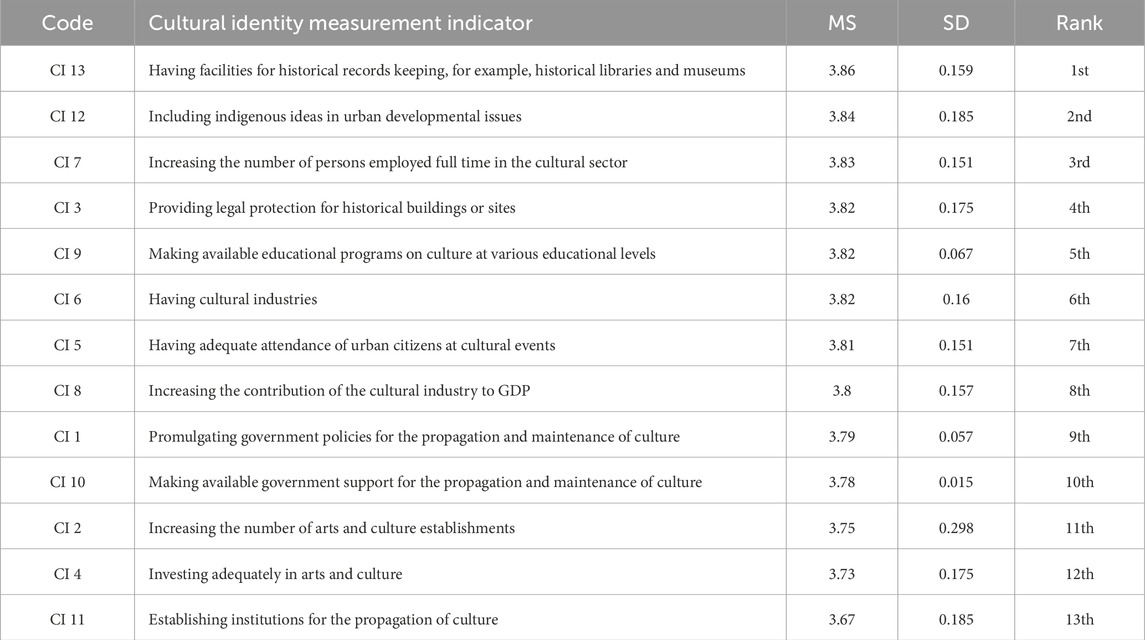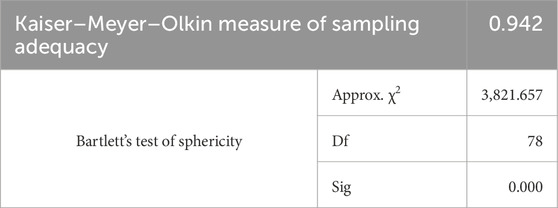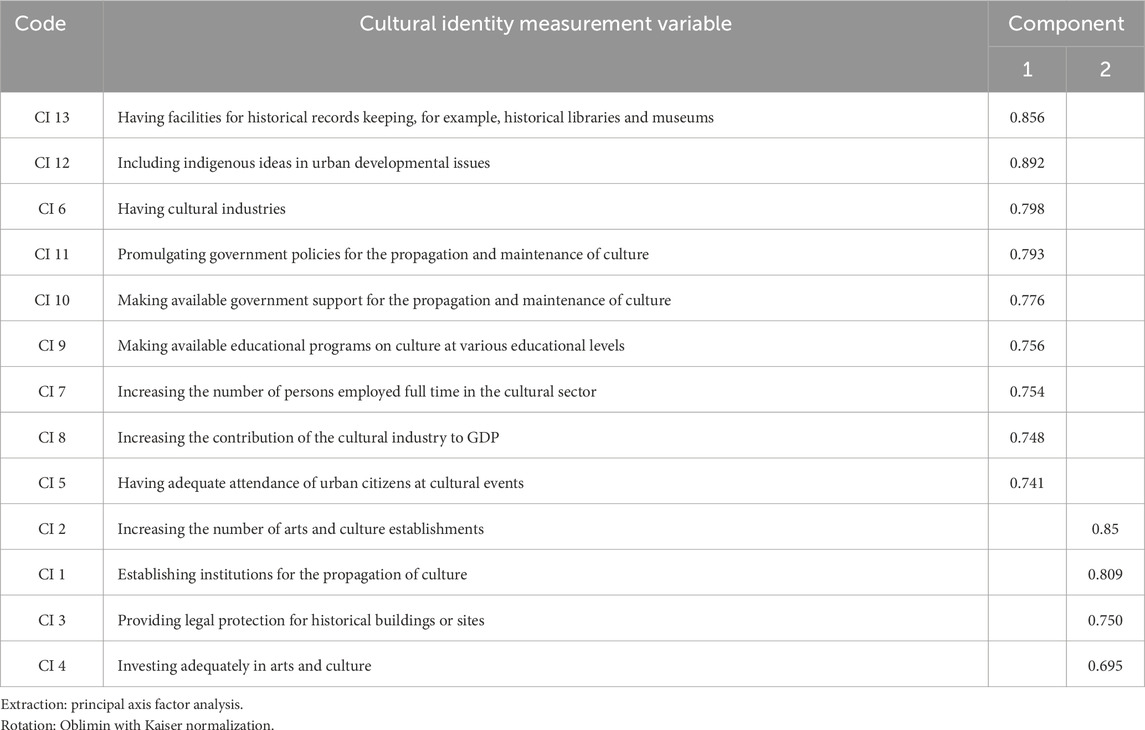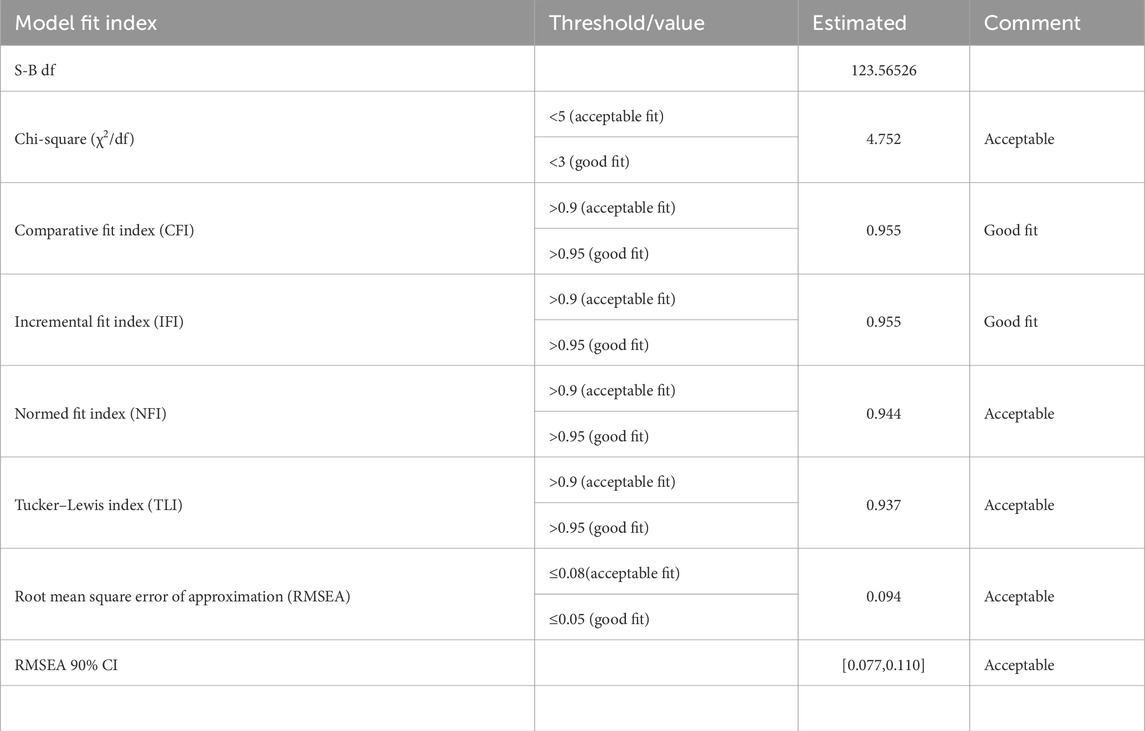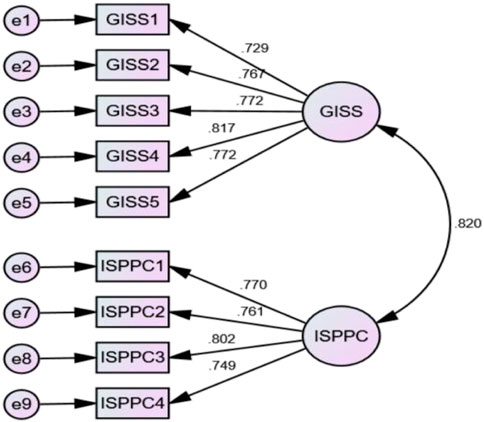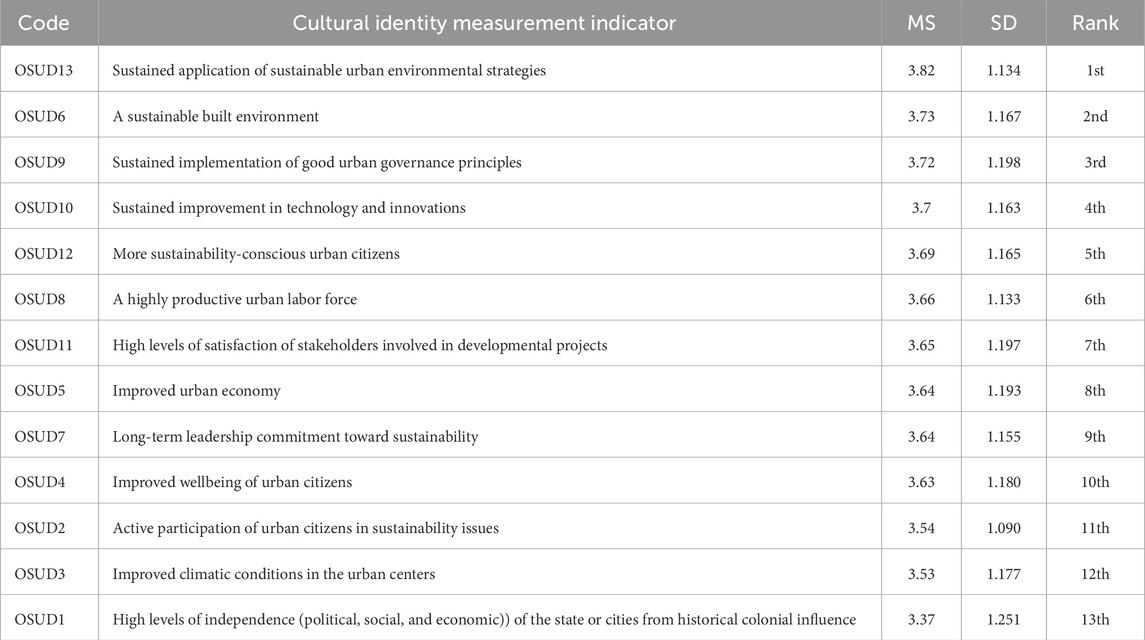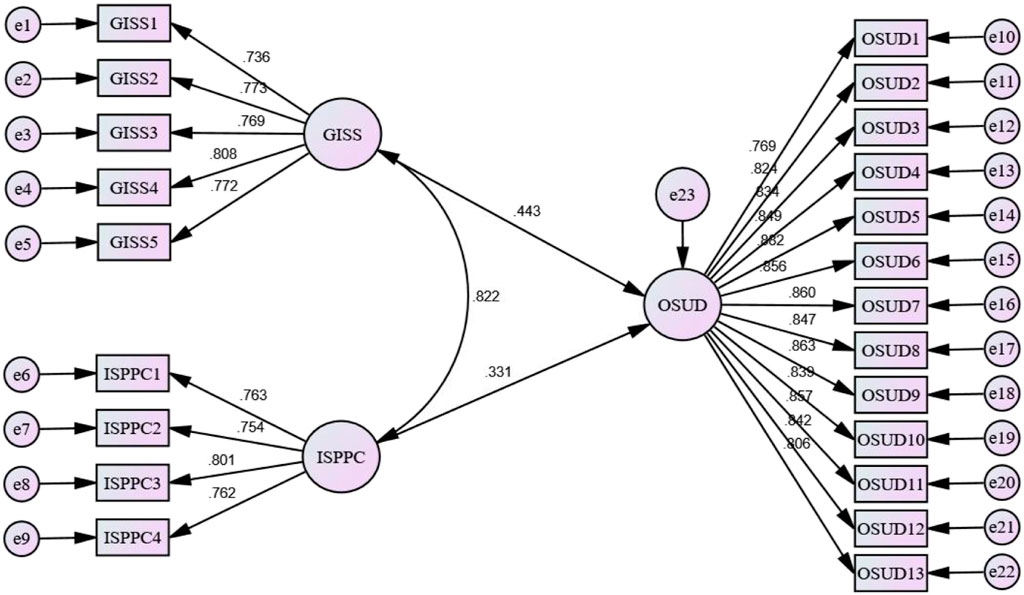- 1Department of Building Technology, Faculty of Built and Natural Environment, Koforidua Technical University, Koforidua, Ghana
- 2Centre for Sustainable Development (CenSuD), Koforidua Technical University, Koforidua, Ghana
- 3Department of Civil Engineering, Faculty of Engineering, Built Environment and Information Technology, Walter Sisulu University, East London, South Africa
- 4Department of Construction Management and Quantity Surveying, Faculty of Engineering and Built Environment, University of Johannesburg, Auckland Park, South Africa
- 5Department of Quantity Surveying, Auchi Polytechnic, Auchi, Nigeria
Purpose: An urban center’s cultural identity (CI) is the tangible and intangible elements instituted and incorporated in the urban placemaking process to provide individuals or groups with their identity, sense of belonging, and ownership. With recent trends in urban growth, especially in developing countries, an in-depth understanding of the elements or determinants of urban development that will ensure a sustainable urban environment has become critical in the global development discussion. This study investigates the influence of CI and its essential elements of sustainable urban development (SUD).
Design/methodology/approach: A quantitative research method using closed-ended questions from a questionnaire survey was utilized to solicit responses from sampled professionals within the urban planning and development space in four urban centers in Ghana. The data obtained were analyzed by employing exploratory factor analysis (EFA), confirmatory factor analysis (CFA), and structural equation modeling (SEM) to establish the influence of CI and its elements in achieving SUD and to explain the common underlying dimensions of the elements.
Findings: The findings highlight that elements associated with government initiative and support systems and effective institutional structure for cultural development under cultural identity were identified as the most critical elements that influence the achievement of SUD. Furthermore, the hypothesis tested revealed a strong influence of CI in achieving SUD in developing countries.
Research limitations/implications: This study is confined to the influence of CI and its essential elements of SUD.
Practical implications: As part of the practical implications, the study suggests the strong need to consider CI and its elements in the urban placemaking process to attain SUD.
Originality/value: In addition to findings influencing CI and its essential elements of SUD in developing countries, using Ghana as a case study, the study indicates that government initiatives and support systems and institutional structures for promoting and protecting culture are relevant and influential in achieving SUD in developing countries.
1 Introduction
Sustainable development (SD) has become an evolving concept in the past four decades after the Brundtland Report (WCED, 1987), and it continues to gain credence in the socioeconomic development rhetoric of countries across the globe (Holden et al., 2014). Developing countries, though lagging behind the developed nations in implementing the SD principles, have broadly accepted the relevance and importance of the concept. Paramount in the literature on SD is sustainable urban development (SUD). The United Nations (UN), in boosting the agenda of SD, set out the sustainable development goals (SDGs) and related targets aimed to be achieved by 2030 by all nations. One of the critical goals of the SDGs is Goal 11, which deals with sustainable and inclusive cities and communities. This is well affirmed in literature, as SUD is recognized as one of the cardinal areas of focus in achieving the SD concept. Achieving sustainable cities and communities (Goal 11: SCC) globally is crucial to the overall success of implementing the SDGs by 2030, as the UN acknowledges. Cities contribute over 80% to global GDP and account for most environmental and societal issues. It is estimated that some 4.4 billion people—56.2% of the world’s population—live in cities, which is projected to double by 2050 (Adeyemi and Shackleton, 2023; World Bank, 2020). United Nations Department of Economic and Social Affairs (UN DESA) (2018) identified that 90% of the urban growth will be in the developing regions of South and East Asia and Africa (Simkin et al., 2022; Yiran et al., 2020).
SDG 11 (SCC) has seven targets to be achieved by all nations. One of these targets (Target 4) is focused on “strengthening efforts to protect and safeguard the world’s cultural and natural heritage.’’ The UN acknowledged and considered culture as key to the achievement of SUD. The target focused on the world’s cultural and natural heritage, such as the UNESCO-designated sites (UDSs) around the globe. It did not consider the culture and identity of inhabitants at the local level (national and city level). It is accepted knowledge that most developing nations, especially in Africa and Asia, are recognized for the importance they attach to their culture and identity in the development of their societies (Kanu, 2020; Amzat and Razum, 2018). Beneficiaries and inhabitants of cities and communities should identify themselves with and feel a part of the urban development process and sustainable city or community. Seaton (1999) posited that over 2 decades ago, development made room for multiculturalism or cultural diversity either by race, religion, gender, social class, sexuality, or language with no national boundaries. They maintain the CI or heritage of a single nation, city, or community is a more globally acceptable and incorporative approach to the urban placemaking process or planning and development efforts. Based on the foregoing relevance of the local culture to the citizens of most developing countries, it is evident that the issue of cultural identity is crucial to the success of SUD.
The interest in sustainable urban development received a boost from industry and research (Darko et al., 2019; Maqbool and Amaechi, 2022). Ayarkwa et al. (2017) affirmed that implementing SUD approaches in developing countries, such as Ghana, is in its infant stage compared to developed nations. Ametepey et al. (2022a) highlighted urban development and its related infrastructure as a fundamental sector of the Ghanaian economy, and its attention toward sustainability concerns spans the entire industry. Due to numerous barriers, Ghana’s urban development sector has yet to position itself in assuring SUD. Hence, Ghana was selected as the case study location due to its rapid urbanization, rich cultural diversity, and representative characteristics typical of many developing countries in the West African sub-region. Additionally, Ghana faces resource constraints, institutional barriers, and governance challenges common to developing nations, making it an ideal context for exploring how cultural identity influences sustainable urban development amid such limitations. All stakeholders in the urban planning and development sector should be aware of the destructive nature of conventional urban development practices compared to the benefits of sustainable urban development. A literature search suggests that, though cultural identity has become critical in the urban placemaking process, there is a dearth of literature on this subject, especially in developing countries such as Ghana. Against this background, this research was aimed at empirically establishing the influence of CI in achieving SUD in developing countries. Therefore, an in-depth understanding of the relevance and influence of cultural identity (CI) in the urban placemaking process in developing countries to attain SUD is critical. This research will delve into the literature to explain the concept of cultural identity in urban development, elements of CI in SUD, the theory of culture, and the theory of cultural identity. The subsequent sections discuss the methodology adopted for the study, the results and findings of the research, a discussion of the results and their implications to both theory and practice, and a conclusion.
2 Literature review
2.1 Cultural identity in urban development
According to Schwartz et al. (2001), cultural identity refers to how individuals define themselves with the cultural groups to which they belong. CI in the urban placemaking process is critical in maintaining the heritage, traditional beliefs, and other aspects of native cultures, especially for those cultural elements at risk of being overshadowed by dominant cultures, primarily resulting from the impact of internationalism or globalization. CI gives people a sense of belongingness or association and heightened self-esteem (Balanovic et al., 2020). Globalization and internationalism have brought about concepts such as cosmopolitanism (see Appiah, 2016; Arneson, 2016; Blommaert, 2010; Chen et al., 2016), which aims to promote “cultural unionism” or “cultural globalization” (see Luciani, 2020; Ozer, 2019) in the urban placemaking process. Seaton (1999) explained that development that makes room for multiculturalism or cultural diversity (by race, religion, gender, social class, sexuality, and language) with no national boundaries and still maintains the CI or heritage of a single nation is a more globally acceptable and incorporative approach to the urban placemaking process or planning and development efforts. In many developing countries, cultural globalization and internationalism hold the potential to erode indigenous traditions while simultaneously introducing new economic and cultural opportunities (Tomlinson, 1999; Hannerz, 1992). On the positive side, these forces can foster cross-cultural collaboration, boost creative industries, and facilitate technology transfer. However, the influx of foreign ideas and practices may also homogenize local identities, weaken social cohesion, and marginalize vulnerable communities. Such processes highlight the need to integrate local culture into urban planning and development strategies to ensure that cultural identities are preserved. This approach can enhance sustainability by promoting inclusive community engagement, stimulating heritage-based economies, and addressing the complexities of rapid urbanization. The adoption of tangible elements such as cultural building, heritage sites, and local cultural practices, as well as other intangible elements such as the promotion of cultural practices and events in a public or social gathering, presence of culture and native history in educational curriculums, are ways of upholding the CI and giving the indigenes a sense of belongingness.
2.2 Conceptualizing cultural identity in sustainable urban development
In integrating cultural identity into SUD, it is imperative to establish the various aspects of CI termed in this research as “elements of CI” that lead to the achievement of CI in SUD. Two models/tools are identified from literature that sought to consider the factors of culture and CI in the urban placemaking process. Notably, these tools were developed for implementation in developed countries. The models/tools are the sustainability built and environment tool (SuBET) and the Singaporean benchmarking for best practices in sustainable urban development. The SuBET was developed in the United Kingdom by Al-Waer and Clements-Croome (2010) and aimed to enable a holistic assessment of the sustainability of urban centers. Its development has improved over other tools or models such as Leadership in Energy and Environmental Design (LEED) and Green Star. The SuBET has the social, cultural, and economic construct, which has the sub-constructs of culture and perceptual as well as placemaking. The culture and perceptual sub-construct include indicators such as community involvement and cohesion, current local reputation, and sustainable behaviors. Meanwhile, the urban placemaking sub-construct is measured using indicators such as visual and physical connectivity, active frontage, integration and reuse of historic buildings, local material use, and frontage, among others. Table 1 presents detailed information on the CI elements considered by SuBET.
Culture is one of the 13 constructs captured under this framework and has four sub-constructs. The first sub-construct is cultural institutions and enactment and has indicators such as the number of arts and culture establishments, the number of cultural events displayed in public, the extent of local practices or cultural involvement in national or public activities, and existing mechanisms to support culture. The second sub-construct, culture milieu, has indicators that include the number of attendances to arts and culture events annually, the number of tickets to culture performances sold or purchased annually, heritage sites and buildings legally designated for conservation and accessibility space for creative practitioners to display, create, and practice their works. The third sub-construct is culture and economy and has indicators such as the extent of government funding for culture programs, the number of persons fully employed in the arts and culture sector, the total contribution of arts and culture to the national GDP, and the existence of plans for long-term investment in arts and culture. The last sub-construct is education for culture, which includes the indicators of students in degree-granting arts and culture programs and the degree of incorporating arts and culture into the school’s curriculum. The details of the CI elements considered by the benchmark, best practices, and framework for sustainable urban development for Asian cities are presented in Tables 2, 3, and Figure 1.
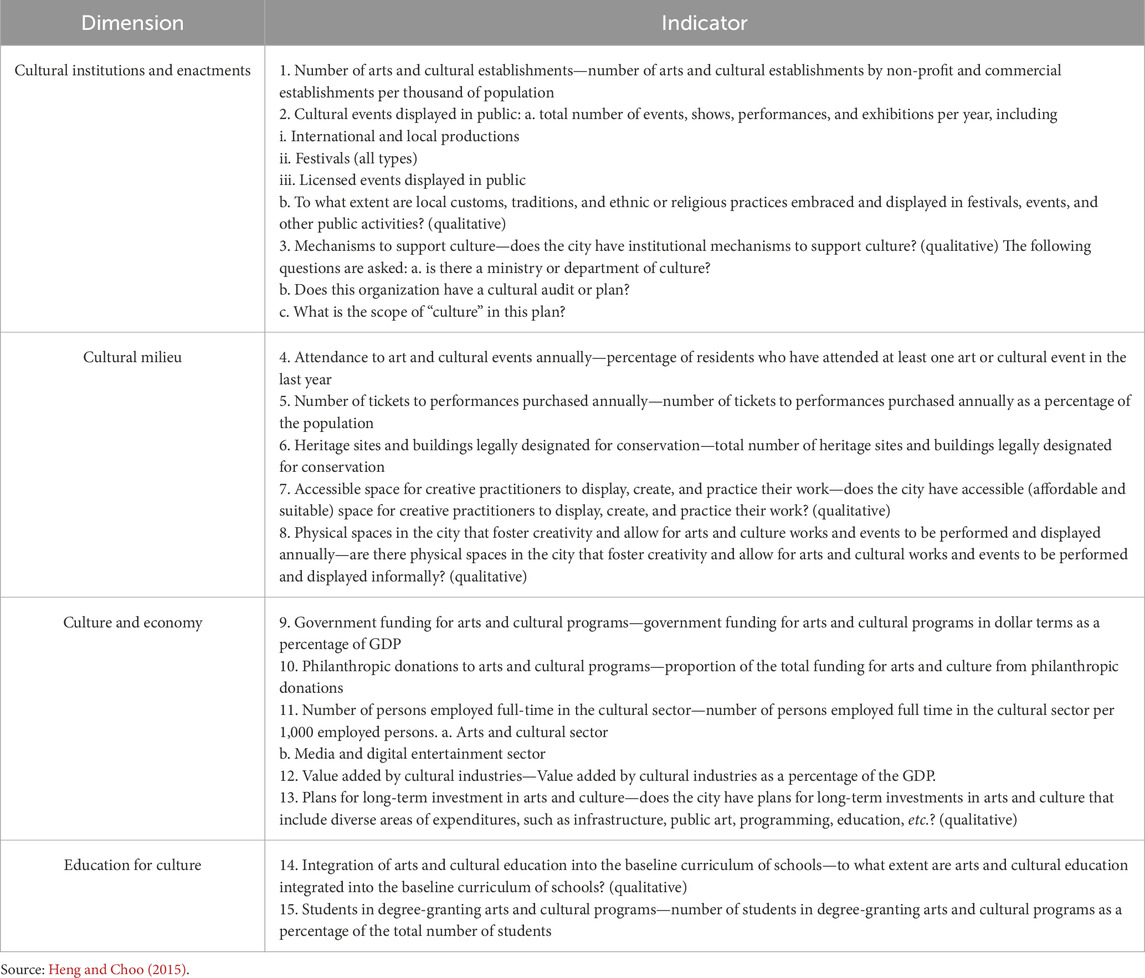
Table 2. CI elements considered by the benchmark, best practices, and framework for sustainable urban development for Asian cities.
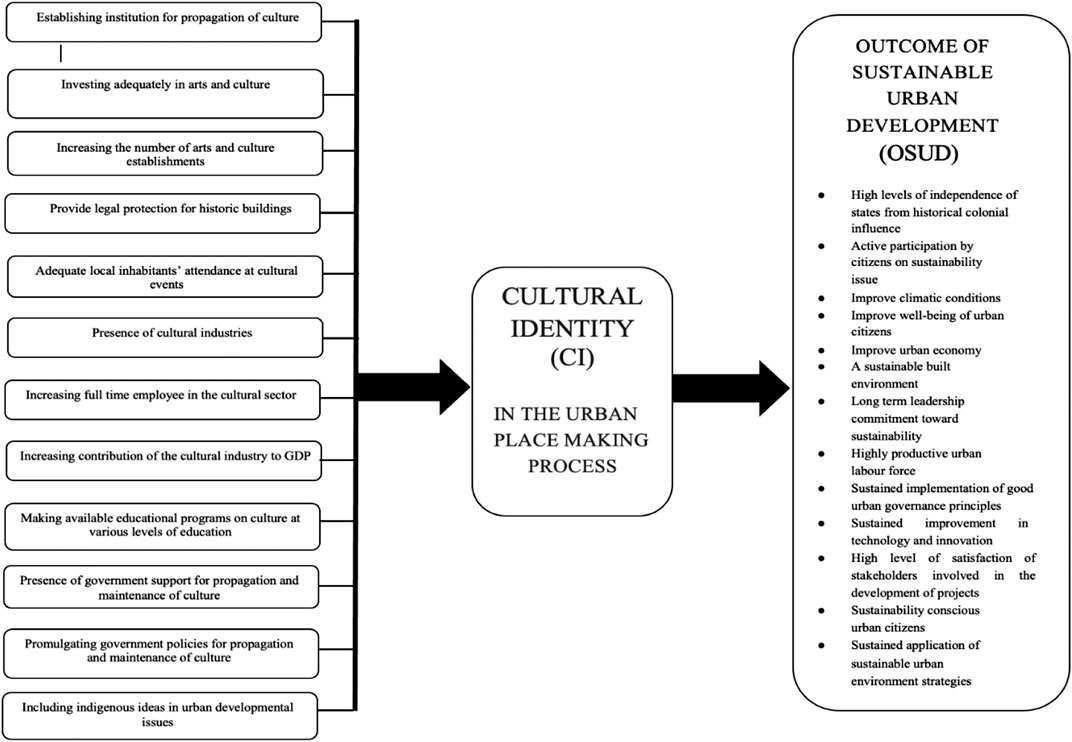
Figure 1. Conceptual framework of the elements of CI in achieving SUD outcomes in developing countries as identified from the literature.
2.3 The theory of cultural identity
Culture is viewed from the social science and anthropological perspectives. Social scientists view culture as the way of life of people, communities or nations, and social groups (Hall, 2002), and anthropologists identify culture with that “complex whole” (see Taylor, 1871; Boas, 1910), which involves elements such as knowledge, belief, art, morals, law, customs, and many others. Culture is characterized by certain inherent behaviors, values, beliefs, and ways of life, which shape the identity of people, societies, and even nations and uniquely distinguish them from others. Identity is, therefore, inherent in the culture of people or groups of people. Identity as a concept has been broadly viewed in several facets, such as the individual self, rational self, and collective self, with various interpretations that include elements that build, shape, and change us (our identity) and cover our interactions with others, the structure of our societies and our past experiences or history (Essays UK, 2018). Identity as the individual self and collective or group identity is relevant to this study. For the relevance of this study, identity gives us an understanding of who we are internally and externally to the outside world (Essays UK, 2018), individually or as a group.
CI symbolizes the complete sense of one's “self” or “identity” both as an individual and as a group in their interaction with themselves or the world outside of themselves (Baskin, 2019). CI gives the notion of belonging to a “group culture.” Group culture refers to factors such as ancestry, attitude, appearance, history, nationality, political attitude, profession, religion, skills, social class, family, education, and ethnicity, amongst other things (Baskin, 2019). Similarly, dissenting opinions such as Chandler and Munday (2011) stipulate that the CI concept can be stereotyped into a sense of “differentiating” or “otherness.” Chandler and Munday (2011) explain that this sense of differentiation or “pigeon-holing” these “other” groups of people could be based on a broad range of attributes ranging from race, ethnicity, gender, religion, and language to nationality and even social classes or social groupings. Irrespective of this dissenting ideology, CI in quintessence identifies one's true self as an individual or group as seen by oneself or others. Notwithstanding the benefits globalization and internationalism bring to growth and development, they have been identified as a setback to creating CI in modern-day urban spatial development, especially in developing countries, as they seek to attain the homogenization of global cultures through the concept of cultural globalization (Luciani, 2020). Learning and accepting cultural differences should become part of modern-day spatial planning development. (Geertz, 2000, p.89) highlights the importance of acceptance of difference by stating that: “Imagining differences is the first step in acceptance of others. They, in turn, have the same right to build their awareness of freedom as long as their actions do not prevent one from enjoying that same freedom. It is not that we must love one another or die. It is that we must know one another and live with that knowledge. We must learn to grasp what we cannot embrace. It is in this, strengthening the power of our imaginations to grasp what is in front of us, that the uses of diversity and the study of diversity lie.”
3 Research method
The methodology adopted for this study is presented in this section. Positivist knowledge, a type of research philosophy, underpins this research. Maqbool et al. (2022), Ebekozien (2019), and Bryman (2016) affirmed that a research philosophy is based on the researchers’ presumptions while conducting the investigation. The study collected primary data via a questionnaire survey. Ayyash et al. (2011) asserted that it is the most excellent strategy to use when researchers have prior knowledge of the population, as is the situation in this study. It was used to explore how CI can influence developing nations to achieve SUD. The units of analysis are the elements of cultural identity, which influence the achievement of SUD in developing countries and the SUD outcomes. The study covered four (Accra, Kumasi, Cape Coast, and Tamale) of the most urbanized centers of 16 in Ghana (Ghana Statistical Service, 2012). Snowball sampling was utilized to select professionals in the urban development space who have knowledge of SUD and the issue of cultural identity in the selected centers. Israel (1992) avowed that the technique is well known for conveniently acquiring data from most concerned people. The study’s population includes professionals in the urban planning and development space (both academic and industry), such as architects, town and urban planners, sustainability experts, civil engineers, project managers, and building technologists. Others are municipalities’ executive management and operations officers, development practitioners, NGOs, and civil society groups. In total, 430 usable questionnaires were retrieved from the study. The respondents’ distribution was as follows: 178 from Accra, 132 from Kumasi, 92 from Cape Coast, and 28 from Tamale.
The 13 elements presented in Table 3 were the variables measuring CI and SUD outcomes as identified from the literature, and their level of influence in achieving SUD was tested through the questionnaire survey. The answers to the survey questions took the form of a five-point Likert scale ranging from no influence to major influence. The net score of all the factor items represented the mean of CI. A Likert scale is simple to use and reduces uncertainty and inaccuracy (Hayes, 1992). Of the 622 questionnaires administered, 430 usable questionnaire responses were received after a series of reminders by email and phone calls. Regarding the measurement and operationalization variables, the items/dimensions were adopted from scales already developed by previous researchers. Some adjustments to the wording were made where needed. Concerning ethical issues, the researchers attached a letter of introduction to seek permission from the respondents before the study was conducted. Based on the significant constructs found in the literature, the survey instrument for the study was created, and the necessary statistical tools were adopted for data analysis.
4 Analysis of results
A total of 430 (69%) valid responses were received from the 622 questionnaires sent out. Referring to Table 4, note that respondents of the study had sufficient working experience, as 41.0%, the largest group, had work experience between 5 and 10 years, 30.3% had experience of 1–5 years, and the remaining 28.7% had worked between 11 and 30 years. This result indicates that the respondents have the requisite experience and are well placed to respond to the study questions.
4.1 Reliability and validity
Table 5 summarizes the study’s Cronbach’s alpha, composite reliability, and average variance extracted. The convergent and discriminant validity of the data was determined by Cronbach’s alpha of not less than 0.70 for all 13 variables of CI, composite reliability (CR) for all constructs was not less than 0.70, and average variance extracted of each construct was not less than 0.50 (Hair et al., 2013). Hair et al. (2013) opined that Cronbach’s alpha value above 0.70 is considered acceptable. This research fulfills the minimum requirement of Cronbach’s alpha in the case of all variables in the study. The discriminant validity was measured by comparing the square root of the average value extracted (AVE) of constructs with the correlations between the constructs (Hair et al., 2012), which also reflects the satisfactory conditions of the data, as highlighted in Table 5.
4.2 Validation of the variables (elements) of cultural identity
The study established 13 variables or elements measuring cultural identity (CI) from the literature, as shown in Table 3. The research sought to validate the elements of CI to ensure that they are still relevant in the developing country context. A five-point Likert scale ranging from 1 being “no influence” to 5 being “major influence” was used. From the analysis, any mean score value less than 3.0 is deemed insignificant for the study because it falls below the neutral rating of 3.0. Standard deviation values of less than 1.0 indicate consistency in agreement among the respondents on the reported level of results (Field, 2009). Therefore, to rank the variables fairly, where two or more variables have the same mean score, the one with the lowest standard deviation was assigned the highest importance ranking. Table 6 summarizes the results of the analysis of the elements of cultural identity in achieving SUD in developing countries. Table 6 indicates that the mean scores of the thirteen variables ranged from 3.860 (having facilities for historical records keeping, for example, libraries and museums) to 3.730 (establishing institutions for the propagation of culture), with an average score of 3.790. Table 5 further revealed that all the elements of CI were significant as their mean score exceeded the set benchmark of 3.00 as previously stipulated. Based on the overall mean score, the three elements of CI that were highly ranked as most influential are having facilities for historical records keeping, such as libraries and museums (3.860); including indigenous ideas in urban development issues (3.840); and increasing the number of persons employed full-time in the cultural sector (3.83). Because all 13 variables were significant based on the participant’s responses, they were all considered for the exploratory factor analysis.
4.3 Exploratory factor analysis (EFA) of the elements of cultural identity
EFA was employed to reduce the thirteen variables (elements) of CI into a limited set of underlying factors, explaining the elements, and establishing the correlation between them. Asante et al. (2018) and Ametepey et al. (2022b) emphasized that factor analysis is constructive for finding groups of related variables and is thus ideal for reducing many variables into a more easily understandable structure. The fundamental function of FA is to investigate the underlying variance of a set of correlation coefficients, compressing data contained in original variables into a smaller group of factors with minimum data loss (Syed and Mohammed, 2009). To determine if the samples are sufficient for factor analysis, the Kaiser–Meyer–Olkin (KMO) measure of sampling adequacy and Bartlett’s test of sphericity were conducted. The KMO examines sample adequacy, while Bartlett’s test examines the null hypothesis of whether the original correlation matrix is an identity matrix. A sample is adequate if the value of KMO is not less than 0.5 (Field, 2009). Referring to Table 7, the KMO value obtained is 0.942. In contrast, the χ2 value obtained by Bartlett’s test of sphericity is 3,821.657 with a significant value of 0.000, indicating that the null hypothesis of the correlation matrix being identical is rejected; hence, there exist significant correlations in the data set, making it appropriate for factor analysis. Thus, the samples satisfy the condition for factor analysis.
Communalities were extracted on each element and were set at a minimum of 0.3 for adequacy for use in EFA, consistent with Field (2009) and Hair et al. (2013). All the elements or variables yielded a value greater than 0.5 at the initial iteration, qualifying them for further analysis. The EFA used the principal axis factoring method with an oblimin rotation. After satisfying the necessary condition for factor analysis, the eigenvalue and factor loadings were set at 1.00 and 0.50, respectively. Table 8 shows two extracted components based on a minimum eigenvalue of 1.0 and a factor loading of 0.5 (Field, 2009; Hair et al., 2013). The two components explained 61.25% of the total variance of the 13 variables examined. By using direct oblimin with Kaiser normalization tools to rotate the components, the result is 94.52% of the total variance of the constructs. The 94.52% total variance is well above the 50% minimum threshold required (Field, 2009).
Referring to Table 8, the variables adequately loaded onto the two components extracted, indicating that the two extracted components are the top perceived CI features in influencing SUD in developing countries. Based on the careful assessment of the inherent relationships among the variables under each component, the following theme was inferred to represent the underlying dimensions of the components. The two underlying components (C1 and C2) that explained the 13 measurement variables from the total variance explained and rotated matrix are labeled as government initiative and support systems (GISS) for component one and institutional structure for protecting and promoting culture (ISPPC) for component two. The GISS component was adequately predicted by nine measurement variables. These variables were CI 5, CI 6, CI 7, CI 8, CI 9, CI 10, CI 11, CI 12, and CI 13, and they accounted for 53.91% of the total variance. The measurement variable CI 12 (Establishing community development strategies) had the highest loading of 89.2%, followed by CI 13 (Having facilities for historical records keeping, for example, historical libraries and museums) with 85.6% variance. The least two significant measurement variables were CI 9 (Making available educational programs on culture at various educational levels) and CI 5 (Having adequate attendance of urban citizens at cultural events), with the factor loadings 75.60% and 74.10%, respectively, as presented in Table 9.
Component two—ISPPC—was adequately explained by four (4) measurement variables (CI 2, CI 4, CI 3, and CI 1) and accounted for 40.62% of the total variance. The variables comprising CI 2 (Increasing the number of arts and culture establishments) had the highest loading of 85.5%, with CI 4 (Investing adequately in arts and culture) having the lowest loading of 69.5%. All thirteen measurement variables had a factor loading >0.4 unto their underlying components C1 and C2, as shown in Table 9 rotated matrix for cultural identity. This indicates the strength of the loading of the measurement variables unto the two components. A factor correlation of 0.725 means a strong correlation between the two components, GISS (C1) and ISPPC (C2).
4.4 Confirmatory factor analysis
The GISS component recorded a Cronbach’s alpha value of 0.88 and ISPPC of 0.85, indicating good construct reliability and internal consistency of the measurement scale used (Hair et al., 2010; Nachiappan et al., 2014). Furthermore, the CFA’s composite reliability (CR) index recorded for the data was 0.912 and 0.901 for GISS and ISPPC, respectively. These are larger than the minimum threshold of 0.7 (Hair et al., 2009), indicating the construct’s predictability and dependability. Details about the validity and reliability of the entire variables measuring CI were presented in the earlier section of this article. A correlation matrix was used to determine the instrument’s validity for the test. The measurement validity of the correlation matrix was assessed using the average value extracted (AVE) as the shared value, convergent validity, and discriminant validity. Discriminant validity is attained by the square root of a construct’s AVE being larger than the correlation with the other components (Fornell and Larcker, 1981; Ebekozien et al., 2022). The AVE also indicates the approximate total components of variation in the indicators that a latent concept is responsible for, with a value of 0.4 deemed suitable (Fraering and Minor, 2006; Hair et al., 2010). AVE values of 0.675 and 0.698 were recorded for GISS and ISPPC, respectively, as shown in Table 5.
Hair et al. (2013) explain that the convergent validity of an instrument indicates the extent of a substantial fraction of the variance of the elements or variables. Convergent validity describes how well a scale correlates with other measures of the same construct in the same direction. A minimum loading for the GISS component was 0.729, and a maximum of 0.772 was recorded. Similarly, the ISPPC component had a minimum factor loading of 0.749 and a maximum of 0.770. These results are consistent with Carlson and Herdman (2012), who asserted that values that deviated from 1.0 showed lower convergent validity than values closer to 1.0, which indicated a higher convergence validity and were hence acceptable.
4.5 Model fit measurement for cultural identity variables
The study employed fit indices to ascertain whether the conceptual model fits the collected data. The fit indices adopted to determine whether the conceptualized model fit the data collected were the final measurement model, the correlated error variance terms, and the standardized factor loadings. The initial analysis of CI elements consisted of 11 variables, with 5 observed and 6 unobserved variables. Kline (2015) explained that when acceptable loadings adequately support the fit of each model, then a more likely assumption is that the indicators underlying the factor are fitting and the construct at hand in each latent construct can be held without an error. Based on the threshold defined, the initial measurement model examined showed that the measurement model fit indices were adequate or satisfactory with standardized loadings of more than 0.5. By this, the minimum observed variable’s or item’s variance explained by the construct through the square of the standardized loading is 50%, that is, R2 = 0.5; the minimum standard loading R was ±0.70, which is an indication that the measurement scale is deemed to be desirable. As shown in Table 9, the four main indices are measured: comparative fit index (CFI) of 0.987, incremental fit index (IFI) of 0.987, norm fit index of 0.982, and a Tucker–Lewis index (TLI) of 0.079. Furthermore, the χ2 index was 3.648, with an acceptable threshold of <0.5, and the root mean square error of approximation (RMSEA) was 0.076. Therefore, all the indices were within acceptable thresholds, making the construct CI a good fit for the data, as depicted in Table 10.
Referring to Table 10, a TLI score of 0.937 was above the acceptable fit threshold of 0.9, as stipulated by (Hair et al., 2013; Hu and Bentler, 1999). However, it is essential to note that the TLI is a non-normed fit index (NNFI) and is used due to its non-sensitivity to population sample size as an additional check due to NFI’s sensitivity to a big data set (see James et al., 1982; Bentler, 1990). With a total sample size of 430 and a good model fit index for the data recorded as NFI (0.944), the indices are deemed acceptable, and the model is a good fit for the data. The measurement model for cultural identity elements after rejecting four CI elements is presented in Figure 2.
4.6 Testing the direct influence of the elements of cultural identity on SUD outcomes
The CI measurement variables were tested against SUD outcomes to test the hypothesis for the study. Thirteen SUD outcomes were identified from the literature and validated as relevant in the developing country context by the study participants. The respondents validated the 13 SUD outcomes as pertinent deliverables of the pursuit of achieving SUD in developing countries. The details of the SUD outcomes mean scores obtained with its associated standard deviations and ranking are presented in Table 11.
4.7 Testing of hypothesis
Two hypotheses were proposed for the study:
a. H1, GISS has a direct influence on achieving SUD in developing countries and
b. H2, ISPPC has a direct influence on achieving SUD in developing countries.
From Table 12, the statistically significant influence of H1 and H2 resulted in a p-value of 0.000 < 0.05 for both hypotheses. This indicates that H1 and H2 hold. The results indicate that GISS directly influences achieving SUD, and ISPPC also directly influences achieving SUD in developing countries; hence, neither hypothesis was rejected. Furthermore, the statistical examination of H1 and H2 resulted in positive path coefficient values of 0.443 and 0.331, respectively. These results suggest that the influence of CI with its elements on SUD in developing countries is statistically significant. Figure 3 provides a structural relationship between GISS, ISPPC, and OSUD.
5 Discussion
This research aimed to explore the influence of cultural identity and its elements in achieving SUD in developing countries using Ghana as a study area. The study solicits responses from professionals in the urban placemaking space who are experienced and educated and have the requisite knowledge of SUD. The results showed that the study respondents qualified beyond the experience and expertise required to participate. Over two-thirds of the respondents had working experience from 6 years to more than 20 years. Most (75%) of the respondents also had between a first degree and Ph.D.-level academic qualifications. Thus, the responses and data obtained from the field were rich and a true reflection of the situation on the ground.
The elements of CI and outcomes of SUD identified in the literature have been studied in different environments but mainly in developed countries. So, it is imperative to establish whether the elements were relevant in the developing country context. This research found that the 13 elements of CI and outcomes of SUD identified from the literature were validated by the respondents as relevant and influential in achieving SUD in developing countries. This is a critical component. Findings agree with Hwang (2018), who opined that culture-led urban development incorporating local identity is crucial for attaining SUD. The research revealed that the validated elements of cultural identity had two underlying components or groupings, namely, government initiatives and support systems (GISS) elements and institutional structures for promoting and protecting culture (ISPPC) features. The GISS elements allude to government initiatives, programs, policies, and direct government support systems aimed at ensuring the conscious and deliberate efforts toward the integration of CI in the urban placemaking process. The findings agree with those of Hwang (2018), Lee (2007), and Sinclair and Stabler (1997). Hwang (2018) opined that culture-led urban regeneration focused on local identity and could lead to SUD. In addition, Hwang (2018) explained that the presence of cultural industries, preservation of the historical environment, and participation of the local indigenes in decision-making toward the development of urban centers are essential for sustainable urban regeneration. Lee (2007) and Sinclair and Stabler (1997) intimated that investment into destination countries with specific features or unique identities, especially in developing countries, has the potential to impact their economies positively. Efforts toward increasing the contribution of cultural industry to the GDP of countries and an increase in the number of people employed in the cultural sector in the urban centers are critical indicators to achieve the economic potential of culture. Thus, the elements grouped under GISS in attaining CI are crucial to achieving SUD.
ISPPC elements focus on formal and informal institutional setups or structures (i.e., legal, economic, and social) created for the promotion and protection of the cultural identity of the urban centers. Findings agree with North (1990) and Kafka and Kostis (2021). North (1990) identified how formal institutions (formal structures and systems, formal rules and regulations, etc.) and informal institutions (culture and heritage) could impact nations’ efforts toward the attainment of economic growth and development. Kafka and Kostis (2021) found the effect of social change resulting from globalization had led to an affinity for post-materialism as opposed to traditional materialistic values.
The hypothesis tested indicates that notwithstanding the advent of globalization and its concomitant effects like “cultural globalization” and “cosmopolitanism” aimed at the homogenization of global cultures (Luciani, 2020), integrating the cultural identity of the local urban centers in their urban placemaking process is significant (influential) in the attainment of SUD in developing countries. It is, however, essential to note that, with the current rate of globalization in socioeconomic activities, there is the potential for dominant foreign cultures to dilute, overshadow, and annihilate popular local cultures (Luciani, 2020). Apart from the direct effect on local culture, foreign cultures can impact the social and economic life of these developing societies through changes in lifestyle, such as the culture of consumption, fashion, and religious patterns, which may negatively impact the local economy of these developing countries. To ensure the protection of popular local cultures in developing countries, deliberate interventions like the incorporation of tangible elements such as the presence of physical infrastructure for promoting cultural identity, giving a local frontage to the urban center through the preservation of culture and cultural heritage sites, promoting cultural practices in the urban centers among others, are critical to safeguarding and preserving the local culture and identity.
6 Theoretical and practical implications
This study’s research is centered on a model built in the context of varied influential elements of CI in achieving SUD. This study contributes to the theory through a solid theoretical framework of the elements of CI and its influence on SUD outcomes. This study proposed and evaluated a research model to help Ghanaian urban development professionals consider the influential elements of cultural identity to achieve the outcomes of SUD. The research fills this gap in the dearth of literature on CI and its influence on SUD outcomes. The findings of this study underscore the unique socio-cultural dynamics of Ghana, revealing distinctions from existing research in other contexts (Cobbinah and Darkwah, 2016). These differences may stem from Ghana’s specific historical, cultural, and socioeconomic factors that shape its urban development landscape. Comparing these results with those from developed countries highlights notable contrasts, particularly in the role of CI elements. In developed nations, urban development often emphasizes technological innovation and infrastructure, sometimes at the expense of cultural considerations (Cobbinah and Darkwah, 2016). In contrast, Ghana’s approach integrates CI elements, reflecting a holistic perspective on sustainability. These insights suggest that urban development strategies in Ghana should prioritize the preservation and promotion of cultural heritage to achieve sustainable outcomes. However, the applicability of these findings may be limited to contexts with similar socio-cultural characteristics, and further research is needed to explore their relevance in different settings (Yeboah and Obeng-Odoom, 2010). The study recommends prioritizing cultural heritage preservation, active community engagement, and the integration of local CI elements into urban planning strategies. Policymakers and urban planners in developing countries should adopt culturally sensitive approaches that reflect the values and traditions of local communities. Strategic investment in institutional structures such as museums, cultural centers, and heritage conservation agencies is also essential to safeguard cultural identity. Governments can implement these policies by integrating cultural mapping into urban planning processes, establishing local cultural councils to guide development decisions, and including CI-related criteria in building codes and urban development regulations. Additionally, heritage impact assessments should be a standard requirement for major urban projects. Professional capacity-building programs should also be developed for urban development experts and government officials to enhance their understanding of CI integration, including training workshops, knowledge-sharing platforms, and partnerships with cultural institutions. These targeted recommendations can guide practitioners and policymakers in implementing culturally responsive and SUD initiatives across developing country perspectives. This study’s practical implications are aimed at urban development experts, government officials, and all other interested stakeholders in the urban placemaking process within the urban development space. The study provides information for practitioners to learn about cultural identity and its influence on achieving SUD in developing countries. In implementing SDG 11 (Sustainable Cities and Communities), developing countries must consider the CI of the local indigenes to achieve this goal. The findings imply that the Ghanaian urban development space should consider the elements of CI established by the study in achieving SUD. Urban development professionals/experts must also take professional courses to improve their knowledge of cultural identity and its elements to attain SUD.
7 Limitations and areas for future study
The study adopted data from Ghanaian urban development professionals. It is worth noting that Ghana has all the characteristics of a developing country and is in the cultural sub-region of the continent and West Africa in particular. The choice of Ghana as the case study enhances the research value due to its position as a rapidly urbanizing country within the culturally diverse West African sub-region. Ghana’s urban development experiences reflect broader dynamics common to many developing nations, making it a valuable context for exploring how cultural identity influences SUD outcomes. This grants a good representation of what pertains to other developing countries, especially on issues relating to the CI of the African urban centers. The study focused on influential industry-specific CI elements/indicators for achieving SUD in developing countries. However, this study collected data primarily from urban development professionals in four Ghanaian cities, namely, Accra, Kumasi, Sekondi–Takoradi, and Tamale, with notably uneven respondent numbers. One of the reasons for this was the willingness and availability of respondents to partake in the study. Accra had 178 respondents compared to only 28 from Tamale. Although Accra, as the capital city, provides substantial insights due to its diversity and rapid urbanization, the limited representation from cities such as Tamale may affect the overall balance and generalizability of the results. Future studies should aim to address this imbalance by ensuring more evenly distributed participation across different cities, clearly defining the criteria for city selection, and enhancing representativeness to improve the transferability of the findings within Ghana and other developing countries.
Regarding areas for future studies, the proposed model could be simply applied to other investigations in the future, and the results could be compared. A mixed-method (both quantitative and qualitative) approach should be adopted for a future study, and the findings should be compared to this current study because it utilized the quantitative approach. In addition, the impact of recent concepts such as cultural globalization and cosmopolitanism evolving from globalization and how it may impact the CI of urban centers in developing countries should also be examined. Furthermore, for greater generalizability of the study’s findings, further research should be conducted in other developing countries, exploring cultural identity and its related elements in achieving SUD.
8 Conclusion
The role of globalization in a nation’s development cannot be underplayed. However, globalization has also resulted in concepts such as internationalism, cultural globalization, and cosmopolitanism, which seek to unify global cultures and discourage the need for the creation of urban centers identifiable by their unique CI. The study identifies that notwithstanding the influence of cultural globalization and global cosmopolitanism with the potential of overshadowing local popular cultures with more dominant cultures from developed countries, the need to incorporate CI in the planning and developing urban centers in developing countries is still very relevant for urban players. This study aimed to determine the influence of cultural identity in achieving sustainable urban development in developing countries. The findings in the discussion provided empirical evidence supporting the significant influence of specific elements of cultural identity on sustainable urban development (SUD). The two identified dimensions, namely, government initiatives and support systems and institutional structures for promoting and protecting culture, emerged clearly through factor analyses and were statistically validated by the SEM results. Critically, the discussion highlighted how each of these dimensions individually contributes to urban sustainability outcomes, emphasizing that while government-led programs directly shape urban policies and resource allocation, institutional structures ensure the long-term preservation and integration of cultural heritage. Thus, the explicit analysis of these CI components reinforces their strategic importance, suggesting targeted interventions for policymakers and practitioners to achieve sustainability in urban development. This study contributes to both theory and practice by empirically validating the relationship between cultural identity and sustainable urban development within the context of a developing country. The main findings revealed that cultural identity significantly influences sustainable urban outcomes, especially through two key dimensions: government initiatives and support systems and institutional structures for promoting and protecting culture. Theoretically, the research advances understanding by offering a framework that links cultural identity to urban sustainability, contributing to existing literature that has largely overlooked this connection in developing country contexts. Practically, the study provides evidence-based recommendations for policymakers and urban development professionals to integrate cultural identity into urban planning strategies. These include establishing local cultural councils, implementing cultural mapping, and institutionalizing heritage impact assessments. Despite its contributions, the study acknowledges certain limitations, such as uneven sample distribution across cities and the focus on one national context. These limitations, however, open pathways for future research to expand and refine the model across different regions and integrate mixed-method approaches for deeper analysis.
Data availability statement
The raw data supporting the conclusions of this article will be made available by the authors, without undue reservation.
Ethics statement
Written informed consent was obtained from the individual(s) for the publication of any potentially identifiable images or data included in this article.
Author contributions
JC: conceptualization, formal analysis, investigation, methodology, writing – original draft, and writing – review and editing. SA: data curation, formal analysis, investigation, resources, writing – original draft, and writing – review and editing. CA: conceptualization, project administration, supervision, validation, and writing – review and editing. EF-J: formal analysis, methodology, resources, software, visualization, writing – original draft, and writing – review and editing. WT: supervision, validation, writing – review and editing, and project administration. AE: supervision, validation, writing – review and editing, and investigation. HA: writing – review and editing.
Funding
The author(s) declare that no financial support was received for the research and/or publication of this article.
Conflict of interest
The authors declare that the research was conducted in the absence of any commercial or financial relationships that could be construed as a potential conflict of interest.
Generative AI statement
The author(s) declare that no Generative AI was used in the creation of this manuscript.
Publisher’s note
All claims expressed in this article are solely those of the authors and do not necessarily represent those of their affiliated organizations, or those of the publisher, the editors and the reviewers. Any product that may be evaluated in this article, or claim that may be made by its manufacturer, is not guaranteed or endorsed by the publisher.
References
Adeyemi, O., and Shackleton, C. M. (2023). Understanding foraging practices in Lagos metropolis to redesign urban greenspaces in support of human-nature interactions. Urban For. and Urban Green. 79, 127805. doi:10.1016/j.ufug.2022.127805
Al-Waer, H., and Clements-Croome, D. J. (2010). Key performance indicators (KPIs) and priority setting in using the multi-attribute approach for assessing sustainable intelligent buildings. Build. Environ. Int. J. Build. Sci. Its Appl. 45 (4), 799–807. doi:10.1016/j.buildenv.2009.08.019
Ametepey, S. O., Aigbavboa, C., and Thwala, W. D. (2022b). Determinants of sustainable road infrastructure project implementation outcomes in developing countries. Sustain. Resilient Infrastructure 7 (3), 239–251. doi:10.1080/23789689.2020.1777926
Ametepey, S. O., Frempong-Jnr, E., and Cobbina, J. E. (2022a). Barriers to the growth of small and medium scale construction enterprises in Ghana. Open J. Civ. Eng. 12, 38–55. doi:10.4236/ojce.2022.121004
Amzat, J., and Razum, O. (2018). “African culture and health,” in InTowards a sociology of health discourse in Africa. Cham: Springer, 65–77. doi:10.1007/978-3-319-61672-8_5
Arneson, R. J. (2016). Extreme cosmopolitanisms defended. Crit. Rev. Int. Soc. Political Philosophy 19, 555–573. doi:10.1080/13698230.2016.1183751
Asante, J., Kissi, E., and Badu, E. (2018). Factorial analysis of capacity-building needs of small and medium scale building contractors in developing countries: Ghana as a case study. Benchmarking Int. J. 25, 357–372. doi:10.1108/BIJ-07-2016-0117
Ayarkwa, J., Acheampong, A., Wiafe, F., and Boateng, B. E. (2017). “Factors affecting the implementation of sustainable construction in Ghana: the architect's perspective,” in ICIDA 2017-6th international conference on infrastructure development in Africa 12-14 april (Knust, Kumasi, Ghana), 377–386. Available online at: https://www.researchgate.net/publication/317277282_Factors_Affecting_the_Implementation_of_Sustainable_Construction_in_Ghana_the_Architect's_Perspective.
Ayyash, M. M., Ahmad, K., and Singh, D. (2011). A questionnaire approach for user trust adoption in Palestinian E-government initiative. Am. J. Appl. Sci. 8 (11), 1202–1208. doi:10.3844/ajassp.2011.1202.1208
Balanovic, J., Stuart, J., and Ward, C. (2020). The chance to look, to examine, to explore: A qualitative study of intercultural contact and cultural identity exploration for Muslim immigrants. Int. Perspect. Psychol. 9 (1), 36–47.
Bentler, P. M. (1990). Comparative fit indexes in structural models. Psychol. Bull. 107 (2), 238–246. doi:10.1037/0033-2909.107.2.238
Boas, F. (1910). Psychological problems in anthropology. Am. J. Psychol. 21 (3), 371–384. doi:10.2307/1413347
Carlson, K. D., and Herdman, A. O. (2012). Understanding the impact of convergent validity on research results. Organ. Res. Methods 15 (1), 17–32. doi:10.1177/1094428110392383
Chandler, D., and Munday, R. (2011). Oxford dictionary of media and communication. Oxford: Oxford University Press.
Chen, S. X., Lam, B. C. P., Hui, B. P. H., Ng, J. C. K., Mak, W. W. S., Guan, Y., et al. (2016). Conceptualizing psychological processes in response to globalization: components, antecedents, and consequences of global orientations. J. Personality Soc. Psychol. 110 (2), 302–331. doi:10.1037/a0039647
Cobbinah, P. B., and Darkwah, R. M. (2016). African urbanism: the geography of urban greenery. Urban Forum 27 (2), 149–165. doi:10.1007/s12132-016-9274-z
Darko, A., Chan, A. P., Huo, X., and Owusu-Manu, D. G. (2019). A sciento-metric analysis and visualization of global green building research. Build. Environ. 149, 501–511. doi:10.1016/j.buildenv.2018.12.059
Ebekozien, A. (2019). “Root cause of demand-supply gap for low-cost housing in Malaysia,” in PhD thesis submitted to the institute of postgraduate studies, universiti sains Malaysia (Malaysia: Pulau Pinang).
Ebekozien, A., Samsurijan, S. M., Amadi, G., Awo-Osagie, I. A., and Ikuabe, M. (2022). Moderating effect of anti-corruption agencies on the relationship between construction corruption forms and projects delivery. Int. Plan. Stud. 27 (3), 336–353. doi:10.1080/13563475.2022.2099354
Essays UK (2018). The concept of identity in society. Available online at: https://www.ukessays.com/essays/social-work/the-concept-of-identity-in-society-social-work-essay.php?vref=1.
Fornell, C., and Larcker, D. F. (1981). Evaluating structural equation models with unobservable variables and measurement error. J. Mark. Res. 18 (1), 39–50. doi:10.1177/002224378101800104
Fraering, M., and Minor, M. S. (2006). Sense of community: an exploratory study of US consumers of financial services. Int. J. Bank Mark. 24 (5), 284–306. doi:10.1108/02652320610681738
Geertz, C. (2000). Anthropological reflections on philosophical topics. Princeton New Jersey: Princeton University Press.
Ghana Statistical Service (2012). 2010 population and housing census: summary Report of final results. Accra, Ghana: Ghana Statistical Service.
Hair, J. F., Black, W. C., Babin, B. J., Anderson, R. E., and Tatham, R. L. (2009). Multivariate data analysis. 6th ed. Upper Saddle River, NJ, United States: Pearson Education.
Hair, J. F., Celsi, M., Money, A., Samouel, P., and Page, M. (2012). Essentials of business research methods. 2nd ed. New York, United States: Routledge.
Hair, J. F. J., Hult, G. T. M., Ringle, C. M., and Sarsteds, M. (2013). A primer on partial least square structural equation modelling (PLS-SEM). NY, USA: Sage publication.
Hair, Jr J. F., Black, W. C., Babin, B. J., and Anderson, R. E. (2010). “Multivariate data analysis,” in Multivariate data analysis, 785.
Hall, S. (2002). The work of representation. Representation: cultural representations and signifying practices. New Delhi, India: Sage publication India Pvt Ltd.
Hannerz, U. (1992). Cultural complexity: studies in the social organization of meaning. Columbia, Columbia University Press.
Hayes, B. E. (1992). Measurement customer satisfaction: development and use of questionnaire. Milwaukee, WI, United States: ASQC Quality Press.
Heng, C. K., and Choo, M. (2015). Benchmark, best practices and framework for sustainable urban development and cities. Singapore: Centre for Sustainable Asian Cities, National University of Singapore. Available online at: http://www.sde.nus.sg/csac/ (Accessed February 10, 2022).
Holden, E., Linnerud, K., and Banister, D. (2014). Sustainable development: our common future revisited. Glob. Environ. change 26, 130–139. doi:10.1016/j.gloenvcha.2014.04.006
Hu, L. T., and Bentler, P. M. (1999). Cutoff criteria for fit indexes in covariance structure analysis: conventional criteria versus new alternatives. Struct. Equ. Model. 6, 1–55. doi:10.1080/10705519909540118
Hwang, H. W. (2018). Creating twenty-first century Korean bodies: public movement education practice, cultural policy and therapeutic ethos. Int. J. Cult. Policy 24 (4), 504–519. doi:10.1080/10286632.2016.1198339
Israel, G. D. (1992). Determining sample size (fact sheet PEOD-6). Gainesville, FL, United States: University of Florida Cooperative Extension Service, Institute of Food and Agricultural Sciences, 1–5.
James, L. R., Mulaik, S. A., and Brett, J. M. (1982). Conditions for confirmatory analysis and causal inference. Atlanta School of Psychology: Georgia Institute of Technology.
Kafka, K. I., and Kostis, P. C. (2021). Post-materialism and economic growth: cultural backlash, 1981–2019. J. Comp. Econ. 49 (4), 901–917. doi:10.1016/j.jce.2021.04.001
Kanu, I. A. (2020). COVID-19 and the economy: an African perspective. J. Afr. Stud. Sustain. Dev. (2), 3. Available online at: https://www.acjol.org/index.php/jassd/article/view/jassd_v3n2_3. doi:10.13140/RG.2.2.18801.43362
Kline, R. B. (2015). Principles and practice of structural equation modelling. Fourth Edition. New York: Guilford publications.
Lee, J. W. (2007). Economic growth and human development in the Republic of Korea, 1945–1992. Reconstruction 1945, 61.
Luciani, R. (2020). Francis and the pastoral geopolitics of peoples and their cultures: a structural option for the poor structural option for the poor. Theological studies. Sage Publ. N. Y. 81 (1), 181–202. doi:10.1177/0040563920906135
Maqbool, R., and Amaechi, I. E. (2022). A systematic managerial perspective on the environmentally sustainable construction practices of UK. Envi- ronmental Sci. Pollut. Res. 29, 64132–64149. doi:10.1007/s11356-022-20255-5
Maqbool, R., Saiba, M. R., Altuwaim, A., Rashid, Y., and Ashfaq, S. (2022). The influence of industrial attitudes and behaviours in adopting sustainable construction practices. Sustain. Dev. 31, 893–907. doi:10.1002/sd.2428
Nachiappan, S., Angappa, G., Jie, Y., Jiang, C., and Kun, N. (2014). Customer satisfaction and competitiveness in the Chinese E-retailing: structural equation modeling (SEM) approach to identify the role of quality factors. Expert Syst. Appl. 41 (1), 69–80. ISSN 0957-4174. doi:10.1016/j.eswa.2013.07.012
North, D. C. (1990). Institutions, institutional change and economic performance. Cambridge, United Kingdom: Cambridge University Press.
Ozer, S. (2019). Towards a psychology of cultural globalisation: a sense of self in a changing world. Psychol. Dev. Soc. 31 (1), 162–186. doi:10.1177/0971333618819279
Schwartz, S. H., Melech, G., Lehmann, A., Burgess, S., Harris, M., and Owens, V.(2001). Extending the cross-cultural validity of the theory of basic human values with a different method of measurement. J. Cross. Cult. Psychol. 32(5), 519–542. doi:10.1177/0022022101032005001
Seaton, J. (1999). Cultural conservatism, political liberalism: from criticism to cultural studies. Univ. Mich. Press.
Simkin, R. D., Seto, K. C., McDonald, R. I., and Jetz, W. (2022). Biodiversity impacts and conservation implications of urban land expansion projected to 2050. Proc. Natl. Acad. Sci. Mar 22 119 (12), e2117297119. doi:10.1073/pnas.2117297119
Syed, M. Q., and Mohammed, N. A. (2009). Constraints to SMEs: a rotated factor analysis approach. South Asian Stud. 24, 334–350.
Taylor, E. B. (1871). Primitive culture: research into the development of mythology, philosophy, religion, language, art, and custom. London: Murray.
Tunas, D., Malone-Lee, L. C., and Heng, C. K. (2021). Urban sustainability indicators: a guidebook. London: Taylor and Francis Ltd.
United Nations Department of Economic and Social Affairs (UN DESA) (2018). “The 2018 revision of the world urbanization prospects,” in Population division of the UN DESA. Washington DC: UN.
World Bank (2020). COVID-19 strategic preparedness and response program (SPRP) using the multiphase programmatic approach (MPA) project: additional financing (English). Washington DC: World Bank.
World Commission on Environment and Development (WCED) (1987). World commission on environment and development. Our common future 17 (1), 1–91.
Yeboah, E., and Obeng-Odoom, F. (2010). 'We are not the only ones to blame': district Assemblies' perspectives on the state of planning in Ghana. Local Gov. Stud. 36 (2), 231–248.
Keywords: culture, cultural identity, developing countries, sustainable development, sustainable urban development, urban growth
Citation: Cobbina EJ, Ametepey SO, Aigbavboa C, Frempong-Jnr EY, Thwala WD, Ebekozien A and Addy H (2025) The influence of cultural identity on achieving sustainable urban development in developing countries. Front. Built Environ. 11:1582670. doi: 10.3389/fbuil.2025.1582670
Received: 24 February 2025; Accepted: 07 April 2025;
Published: 12 May 2025.
Edited by:
Wei Lang, Sun Yat-sen University, ChinaCopyright © 2025 Cobbina, Ametepey, Aigbavboa, Frempong-Jnr, Thwala, Ebekozien and Addy. This is an open-access article distributed under the terms of the Creative Commons Attribution License (CC BY). The use, distribution or reproduction in other forums is permitted, provided the original author(s) and the copyright owner(s) are credited and that the original publication in this journal is cited, in accordance with accepted academic practice. No use, distribution or reproduction is permitted which does not comply with these terms.
*Correspondence: Simon Ofori Ametepey, c2ltb24uYW1ldGVwZXlAa3R1LmVkdS5naA==
 Edward John Cobbina
Edward John Cobbina Simon Ofori Ametepey
Simon Ofori Ametepey Clinton Aigbavboa
Clinton Aigbavboa Emmanuel Yaw Frempong-Jnr1
Emmanuel Yaw Frempong-Jnr1 Wellington Didibhuku Thwala
Wellington Didibhuku Thwala Hutton Addy
Hutton Addy